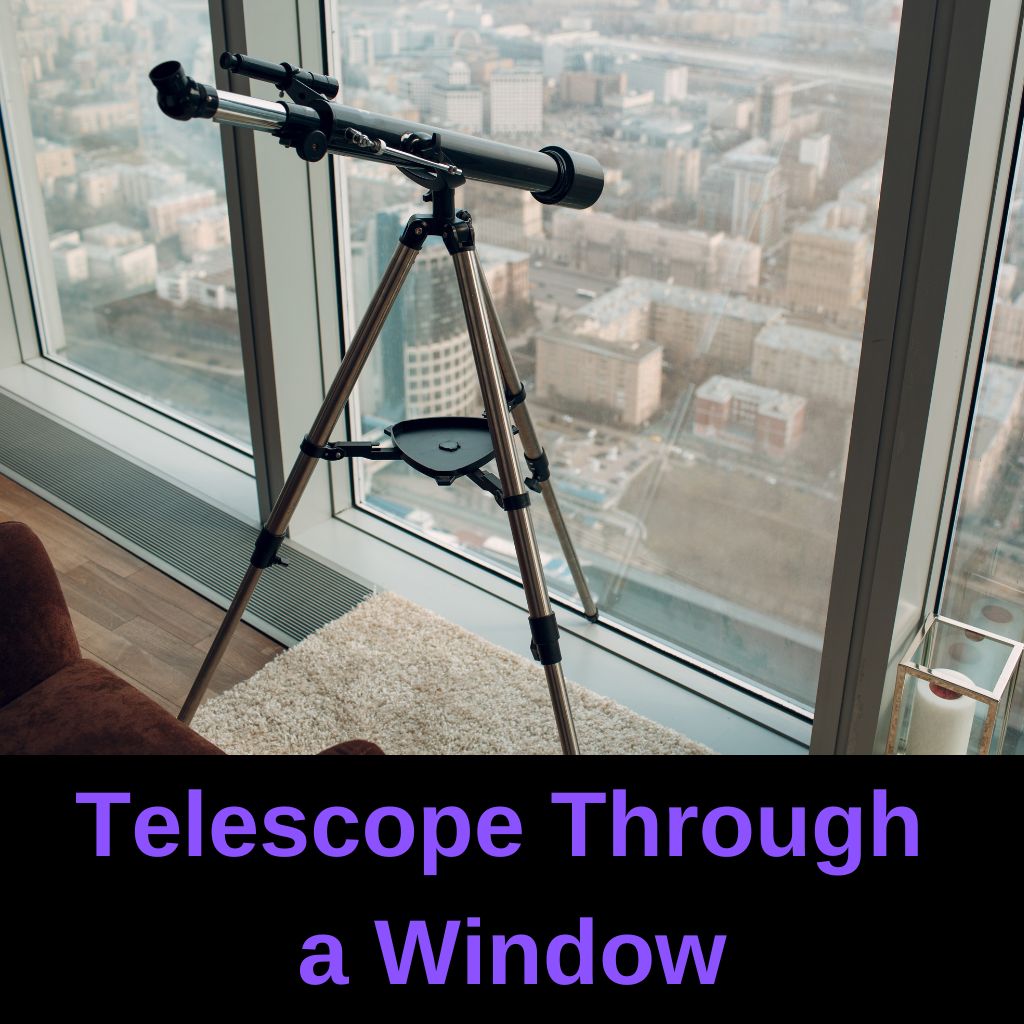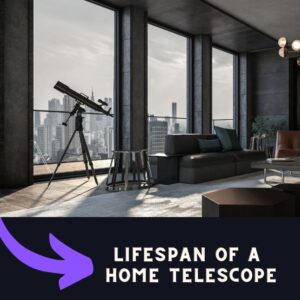This site contains affiliate links to products. I may receive a commission for purchases made through these links.
Exploring the universe while standing in a wide field is easy, but not all of us have access to wide fields that’ll help us embark on a stargazing journey.
Perhaps you live in an urban area, a city, or a flat, making it difficult to get outdoors and explore the universe at night.
But these circumstances shouldn’t make you shy away from your astronomical hobbies and pause your aspirations to journey across the universe and marvel at its wonders.
Using a telescope through your window is possible. It’s not a recommended practice as the glass can cause poor image quality, and if it’s open, you’ll have a restricted field of view. The window can also cause light scattering and reflection, making the image appear less detailed.
That said, you can always employ ways to make your stargazing journey memorable every day. This article discusses everything you need to know on how to use a telescope indoors optimally.
We’ll be looking at some limitations of your telescope while you use it indoors, how you can use a telescope through a window, what you can do best to make the image brighter, and much more. So, keep on reading!
How can you use a telescope indoors?
If you’re an astronomy lover just starting out, you’ll be amazed by anything related to astronomy. Especially when using a telescope for the first time indoors, you’ll still marvel at what you see because you won’t have a point of comparison.
Many astronomy lovers come up with a question: can you use a telescope indoors?
The question comes to mind since many people do not have the luxury of setting out telescopes in an open area.
Even though it is not recommended practice to set up your telescope indoors, some circumstances, like unwelcoming weather, can push you to use your telescope right from your bedroom.
You can use certain techniques and equipment to minimize distortion in your telescope. One option is to use a telescope specially designed for indoor use. Alternatively, you can use an adapter attached to your telescope or use one with a large aperture to increase the amount of light captured.
It’s also important to consider the location and angle where you set up your telescope. The eyepiece focus must be properly set up to get the best view possible.
Indoor observation is very tempting as it proposes an easy way to observe the night sky. But in reality, it brings in more problems.
Some great telescope options for indoor use include the Celestron NexStar 130SLT and the Celestron 70mm Travel Scope.
Read also: Celestron NexStar 130 SLT Computerized Telescope Review
Can you use a telescope through the glass of the window?
Using your telescope through the glass of a window is a practical solution for observing the cosmos from the comfort of your home. But there’s so much more you have to take care of.
The closed window itself will function as a lens for your observation, which affects the overall quality of the image.
It’s important to ensure your window is clean so the telescope can be put at an angle that won’t create any reflections. The room should be dark, and the magnification should be kept low. That’s because the temperature change can distort the images seen using high magnification.
Let’s see some optical limitations that a closed window brings.
Optical limitations of window glass
Peering your telescope through a window glass means inviting many optical limitations that affect the final resolution of the image and expose your telescope to many errors.
Some of these limitations include the following:
- Loss of light. An average window loses around 10% light when passed through, as telescopes need to capture a lot of light in the aperture to produce crisp, clear pictures. The loss of light thus contributes to blurry images.
- Image distortion. Window glass acts as another lens to bend the light. That’s because the glass hasn’t been polished to transmit light accurately, resulting in comas, imaging issues, and optical aberrations for the final image.
- Light scattering. Window glass causes light to scatter, which is problematic as the aperture won’t have enough light to improve the image quality, and you’ll experience halos around bright objects. This makes it hard to observe fine details on celestial bodies.
You may also like to read: Is A Cheap Telescope Worth It?
Can you use a telescope through an open window?
Using your telescope through an open window isn’t that simple. You might think it’s easier than a closed window, where you have to deal with glass obstructions and other factors.
However, there are a bunch of factors to consider before using your telescope through an open window.
It’s important to ensure plenty of space for the telescope to move freely in the window frame. You also need to ensure the telescope is placed on stable ground, is properly mounted, and the ambient temperature in your room is the same as outside.
The difference in indoor and outdoor temperatures is a huge problem because it causes the telescope to shimmer, making the image appear distorted. To see crisp images through your telescope, you need to achieve thermal optimization or thermal equilibrium.
Especially during the winter, it’s next to impossible to achieve thermal optimization to use the telescope for indoor observing.
Other factors like keeping the room dark and choosing an appropriate time for stargazing remain. So, it may be possible to use your telescope without going out, but you might not experience the same viewing quality.
Read also: Can I See Planets With a Cheap Telescope?
What time of day is ideal for using a telescope through a window?
Using a telescope at any time of the day is possible. However, using a telescope during the daytime, especially through a window, isn’t the wisest move.
It won’t be as effective as doing it at night, and you won’t be able to observe celestial bodies and stars as you would in the night sky.
Generally, the best time for observation depends on what you want to see through your telescope.
If you’re observing celestial objects like the stars or plants, the best time is the night when everything is dark. Factors like light pollution can cause your telescope to show blurred images, but you can minimize that by increasing the magnification power.
Moreover, it’s best to utilize equipment that’ll help enhance the image. You should also use a stable tripod to stabilize your telescope and minimize any vibrations that can cause the telescope to alter its image.
What to look for when stargazing from a window
Stargazing provides an awe-inspiring experience that lets us marvel at the beauty of the universe. But what conditions should you meet when stargazing through the window?
If you’re stargazing from a window, you’re likely exposed to a lot of artificial light. So, your best bet is to use a light pollution filter around your window and turn the room dark before you begin your stargazing session.
You can look for the movement of objects in the sky, like satellites, planets, and stars. You can also track moon phases to help observe deep-sky objects and look for bright objects that can be easily spotted, even in areas with high light pollution.
Make sure the telescope you’re using is intact and properly mounted, and choose a suitable time for the best viewing conditions.
What can you see in the night sky from your window?
Celestial objects like the Moon, the stars, planets like Jupiter, Venus, and Saturn, and constellations can be easily seen through a telescope placed indoors.
Also, you can always use a stargazing app to help you locate your favorite planets or just marvel at incredible stars.
One of the easiest sightings you can do is of the Moon. Rising from the East and setting in the West, this celestial object lights up your entire room and shines at a magnitude of around -12.6, making it a majestic bright neighbor that can be easily observed.
Also, it’s possible to easily see some bright planets, including Jupiter, Mars, Venus, Saturn, and Mercury, if you have a clear horizon in the line of sight through your window.
It’s also easy to stargaze at bright stars in the night sky. Stars like Vega, Sirius, and Betelgeuse may be boiling billions of light years away, but they’re easy to spot.
If you’re lucky, you might also be able to catch a shooting star or a meteor flying away in the depths of the universe.
You may also like: What Magnification Do You Need to See Planets?
Why it is not recommended to use a telescope through a window?
Using a telescope through your window means making certain compromises that can affect your image.
It’s generally not a recommended practice as the light entering your telescope can face obstruction, causing blurring or distortion of the telescope image. Also, indoor and outdoor lighting can lead to virtual disturbances too.
Moreover, if you’re using a telescope that’s a bit heavier, it might not sit well on an elevated surface and cause vibrations that ruin the image.
All these play an important role in your telescoping experience from the window, which is why it’s not recommended for serious stargazing.
But if you’re looking for a telescope that’ll work great indoors, try the Celestron AstroMaster 114 EQ or the Celestron ExploraScope 22103.
Telescope type limitations through the window
Any amateur astronomer can choose from three different types of telescopes. These include reflectors, refractors, and Schimdt-Cassegrains.
Read also: Reflector vs Refractor Telescope: Which One Do You Need?
All telescopes are great for viewing distant objects, but the choice narrows down to what you require. For instance, if you’re interested in observing deep-sky objects like nebulae and galaxies, a reflector would be your best choice.
However, that won’t happen when using your telescope through the window.
Using a refractor telescope through the window can significantly impact the image. It uses lenses to focus light, making it challenging to minimize distortions. Reflecting telescopes use mirrors to focus light, which is generally less affected by glass obstruction.
Also, it’s best to use an alt-azimuth mount as it’s simple to set up and more suitable for observing celestial bodies through your window. Using a GoTo computerized mount won’t be possible since you can’t align it with the stars. You need access to the whole sky for this, which you don’t have through the window.
Yes, you can move them with buttons on the hand controller without the star alignment, but this will become an expensive feature without the GoTo capabilities.
It really boils down to choosing a telescope that can be easily stabilized, less affected by glass obstruction, and easy to port.
Takeaway – Explore the universe from the comfort of your room

Exploring the universe from the comfort of your home has never been easier, thanks to advancements in telescopes and equipment that you can use with the telescope.
Nonetheless, it takes away from the experience, especially when looking for deep-sky objects or trying to peer through the depth of the cosmos.
If you don’t mind the limitations, just make sure to set the right atmosphere in your room and choose a suitable time of the day, and you’ll be good to go.
You may also like to read:
- Can’t See Anything through Telescope (Here’s What to Do)
- Maksutov Newtonian Telescopes (In-depth Guide)
- The Best Stargazing App (for Smartphone & PC)
- How To Connect Telescope To Computer
- What Can You See With a 70mm Telescope? (Answered!)
- National Geographic Telescope: NT114CF Review
- Are GoTo Telescopes Worth It? (My Real Experience)








